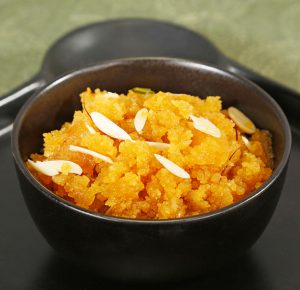Mama’s Punjabi Recipes: Dhuli Moong Di Daal Da Halwa (Yellow Moong Daal Halwa)
With the advent of cold weather, it is the season for sweets, nuts and wonderful aromas like this recipe which can fill any dining table for the Thanksgiving feast. Below is a reprint of Mama’s Dhuli Moong Di Daal Da Halwa recipe, which is a favorite sweet made and eaten in the winter months. It is reprinted with some additional information and directions.
Halwa has existed for centuries in Asia, North Africa, the Middle East, Eastern Europe and the Jewish world. It refers to a dense, sweet confection that can be either slightly gelatinous or flour-based or typically made with suji (semolina) or the crumbling nut-butter kind usually made of tahini (sesame paste) which my kids used to eat very fondly when we lived in Teheran, Iran. Halwa can also be made with sunflower seeds, nuts, beans, lentils (like this recipe) or vegetables like carrots, pumpkins and squashes.
Halwa can be kept for a few days at room temperature without risk of spoilage. In India, suji halwa is often eaten on special occasions or at religious ceremonies, and my family has a tradition of asking for suji halwa with blanched slivered almonds on someone’s birthday. Of course, the first morsel of the halwa had to go to the in-house mandir (temple) to be blessed!
In the Punjab, moong di daal da halwa has a unique appeal and is usually found everywhere the winter months since it is high in calories and is supposed to keep the body warm. It is considered auspicious for Holi and Diwali and these days it is considered chic to serve it even made for weddings.
The halwa is usually made with split, dhuli peeli moong daal (skinless yellow moong lentils), and it takes a lot of patience to sauté and prepare the daal. There are three ways to make it: the original way, the faster way and the short cut, all dealing with the preparation.
In the original way, you must soak the daal for four or five hours, then place it in a grinder to make a coarse paste and then sauté it in ghee (clarified butter). The faster way is to boil the daal in just the right amount of water to let it become tender; drain the water through a sieve, sauté and then add the same water back. The shortcut is to use moong daal flour and prepare like suji halwa by sautéing but the taste is no way close to the other two methods. I know since I have tried all three ways and found the boiling method to be quite good. That’s what this recipe is based on.
Ingredients:
• 1 cup dhuli moong daal (split, skinless yellow daal)
• 5 cups thanda pani (cold water)
• 1 cup tael (olive oil; some may prefer ghee or clarified butter)
• 1 cup chinni (sugar)
• Mewa (dried fruits) to taste: dhule badam (blanched almonds), piste (pistachios), kishmish (raisins), akhrod (walnuts)
Directions:
1. Place the daal and 3 cups of water in a medium sized kadai (wok) and bring to a boil. When the daal is tender, drain the water through a sieve and keep it for the rest of the recipe.
2. Place the sugar in 2 cups of cold water in a small saucepan, let it come to a boil and then set aside. If you prefer a sweeter dish, then add ¼ cup more sugar.
3. Pour the olive oil in the kadai and warm it over medium heat. Put the daal back in and let it roast till it becomes slightly brown.
4. When you see traces of oil come to the sides of the kadai, then add the chasni (syrup water) and stir continuously till the water begins to dry up.
5. Turn the heat to low and when you see oil rise to the sides, then turn off the heat.
6. Sprinkle the dry fruit on top of the halwa before serving slightly warm.
MAMA’S TIP OF THE WEEK: KEEP KITCHEN CLEAR OF OIL AND FLOUR TO KEEP COCKROACHES AWAY
In hot and humid places like Houston, a common nuisance in the kitchen is insects and especially cockroaches of all sizes. The really big reddish ones can grow to 1.5 inches and make a rustling noise when they are scampering around on a counter or in the pantry. In search of food, they even eat into labels on jars and wrapped bars of perfumed soap. And ants can crawl up to open oil containers and fall in and contaminate it.
The best way to naturally get rid of cockroaches is to keep counters and pantry shelves clean of all oil and flour spills. Also, keep all items that emit a smell in tightly closed containers so that the cockroaches will not be attracted to them. Within a week, you’ll see the difference!

Shakuntla Malhotra is a skilled cook of Punjabi dishes made in the old-fashioned style that she learnt as a young woman in her ancestral home in Lyallpur, India (since renamed Faisalabad) before it became part of Pakistan after the Partition in 1947. People have often admired her cooking for its simplicity and taste that comes with each mouthful. Even in her late-eighties, she continues to cook daily and agreed to share her delectable Punjabi vegetarian recipes for future generations.

